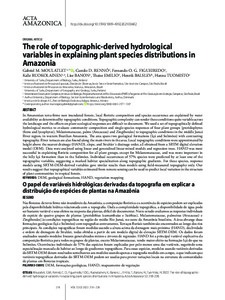The role of topographic-derived hydrological variables in explaining plant species distributions in Amazonia
Moulatlet Gabriel M; Rennó Camilo D; Figueiredo Fernando OG; Ruokolainen Kalle; Banon Lise; Emilio Thaise; Balslev Henrik; Tuomisto Hanna
The role of topographic-derived hydrological variables in explaining plant species distributions in Amazonia
Moulatlet Gabriel M
Rennó Camilo D
Figueiredo Fernando OG
Ruokolainen Kalle
Banon Lise
Emilio Thaise
Balslev Henrik
Tuomisto Hanna
INST NACIONAL PESQUISAS AMAZONIA
Julkaisun pysyvä osoite on:
https://urn.fi/URN:NBN:fi-fe2022102463183
https://urn.fi/URN:NBN:fi-fe2022102463183
Tiivistelmä
In Amazonian terra-firme non inundated forests, local floristic composition and species occurrence are explained by water availability as determined by topographic conditions. Topographic complexity can render these conditions quite variable across the landscape and the effects on plant ecological responses are difficult to document. We used a set of topographically defined hydrological metrics to evaluate community composition and single-species responses of four plant groups [pteridophytes (ferns and lycophytes), Melastomataceae, palms (Arecaceae) and Zingiberales] to topographic conditions in the middle Jurui River region, in western Brazilian Amazonia. The area spans two geological formations (Ica and Solimoes) with contrasting topography. River terraces are also found along the main rivers in the area. Local topographic conditions were approximated by height above the nearest drainage (HAND), slope, and Strahler's drainage order, all obtained from a SRTM digital elevation model (DEM). Data were analyzed using linear and generalized linear mixed models and regression trees. HAND was most successful in explaining floristic composition for all plant groups, except for Melastomataceae, and was more important in the hilly Ica formation than in the Solimoes. Individual occurrences of 57% species were predicted by at least one of the topographic variables, suggesting a marked habitat specialization along topographic gradients. For these species, response models using SRTM-DEM-derived variables gave similar results than models using field-measured topography only. Our results suggest that topographical variables estimated from remote sensing can be used to predict local variation in the structure of plant communities in tropical forests.
Kokoelmat
- Rinnakkaistallenteet [27094]
